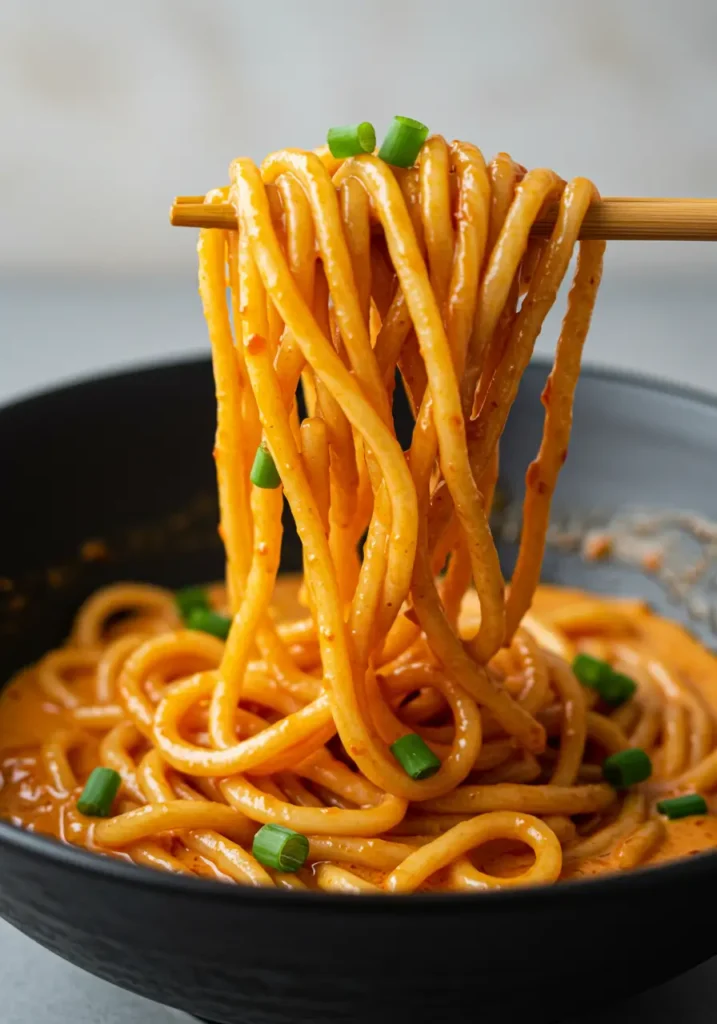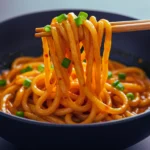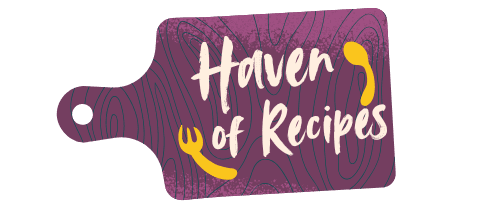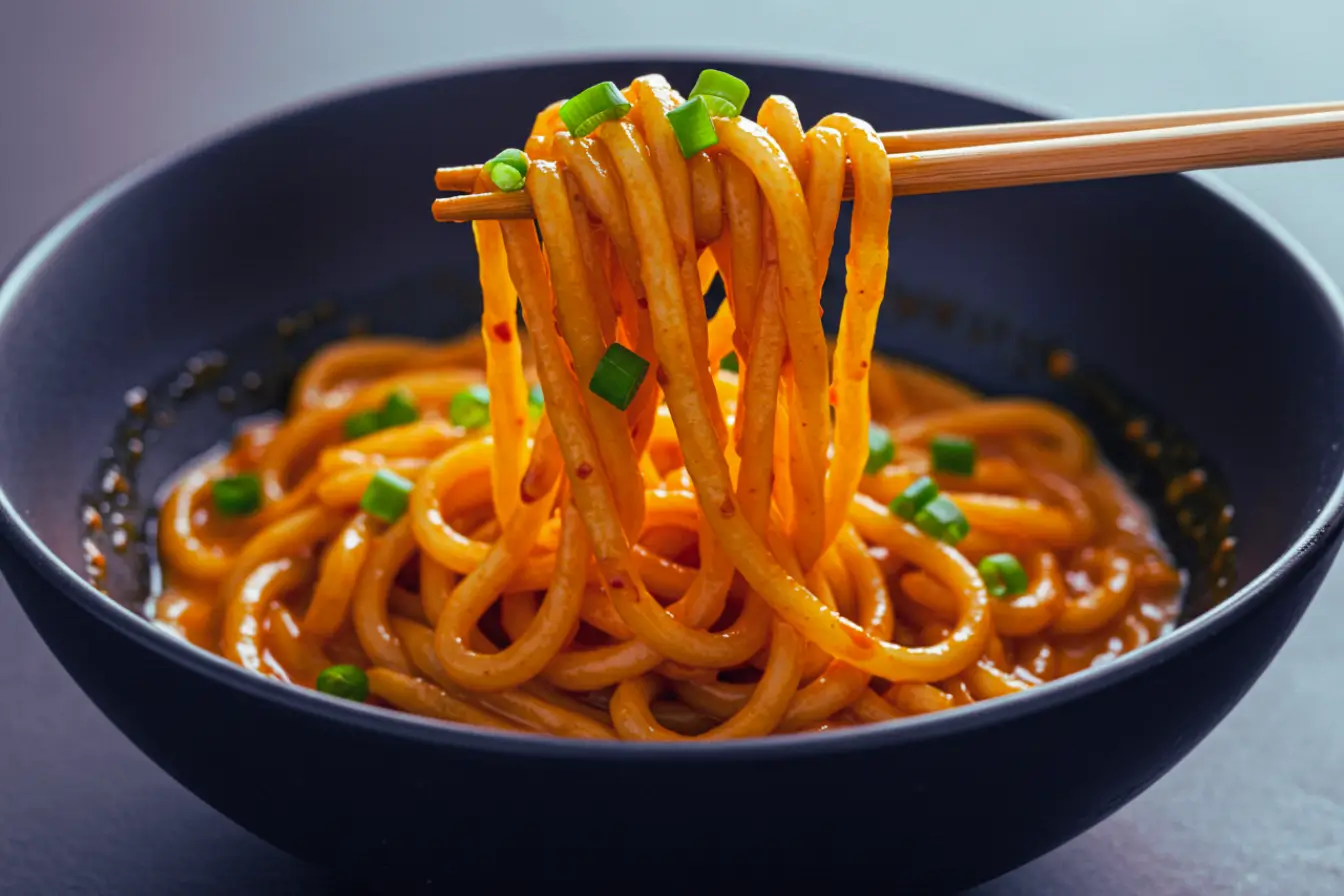This Creamy Gochujang Udon Noodles recipe is the perfect answer for when you need a deeply satisfying and flavorful meal on the table in under 20 minutes. It’s a simple, spicy, and utterly delicious udon stir fry that will quickly become a favorite in your home.
This recipe always reminds me of my adventurous sister, Jennifer. She brought gochujang back from her travels, and we created this dish together in our kitchen. Every spicy, creamy bite is a taste of that joyful memory we made.
What Makes These Noodles So Special?
- Quick & Easy: This entire meal comes together in less than 20 minutes, making it perfect for busy weeknights.
- Minimal Ingredients: You only need a handful of pantry staples to create a restaurant-worthy dish.
- Customizable Spice: Easily adjust the amount of gochujang to make it as mild or as spicy as you like.
- Incredibly Flavorful: The combination of gochujang, sesame, and aromatics creates a rich, savory, and unforgettable sauce.
Gathering Your Ingredients
- 12 oz fresh or frozen udon noodles
- 2 tablespoons gochujang (Korean red chili paste)
- 1 tablespoon soy sauce
- 1 tablespoon sesame oil
- 1 tablespoon honey (or brown sugar)
- 2 garlic cloves, minced
- 1/2 teaspoon grated fresh ginger
- 1 tablespoon vegetable oil
- 2 green onions, chopped
- 1 egg yolk (optional, for serving)
- 1 tablespoon sesame seeds
- Grated Parmesan or cheese (optional)
A Few Helpful Tools from My Kitchen
Before we begin, having the right tools makes all the difference. Here are a couple of my favorites for this recipe.
My Trusty Skillet or Wok
A sturdy wok or a large skillet gives you plenty of room to toss the noodles freely, ensuring every single one gets coated in that beautiful, creamy sauce.
A Little Whisk for a Perfect Sauce
Using a small whisk is my secret for getting the sauce perfectly smooth and emulsified before it ever hits the pan.
Bringing It All Together, Step by Step
First, a Gentle Boil for the Noodles
First, cook your udon noodles according to the package directions. My little tip is to be careful not to overcook them; you want them to have a pleasant, chewy bite since they’ll cook a little more in the sauce. Once done, drain them and set them aside.
Next, Creating That Magical Gochujang Sauce
In a small bowl, whisk together the gochujang, soy sauce, sesame oil, honey, minced garlic, and grated ginger. I like to make sure it’s completely combined so that the flavors are perfectly balanced in every single bite. This is the heart of your Yaki Udon flavor!
Now, Waking Up the Aromatics
Warm the vegetable oil in your skillet or wok over medium heat. Pour in the sauce mixture and let it cook for just a minute or two until you can smell that wonderful garlic and ginger. It should bubble gently.
And Now, the Best Part: Coating the Noodles
Now, add your cooked udon noodles to the skillet. Gently toss them with the sauce until every noodle is beautifully coated. Let it all mingle together for another 2 to 3 minutes, allowing the noodles to absorb all that incredible flavor. This is where it transforms into a perfect udon noodle stir fry.
Finally, Dressing It Up for the Table
Transfer your gorgeous noodles to a serving bowl. Sprinkle generously with the chopped green onions and sesame seeds. If you’re feeling a little extra, a bit of grated Parmesan adds a salty, cheesy note that is surprisingly delicious.
For That Extra Creamy Finish
For that extra touch of creaminess that makes this dish so special, make a small well in the center of your noodles and gently drop in the raw egg yolk. When you’re ready to eat, just break the yolk and mix it all together for the richest, silkiest sauce.

A Quick Word on Nutrition
Please note that the nutritional information provided is an estimate and can vary based on the specific ingredients and quantities you use. It is calculated using an online calculator and should be considered an approximation.
For a Lighter Touch
- Whole Wheat Udon: For an increase in fiber, you can often find whole wheat udon noodles at specialty grocery stores or online.
- Low-Sodium Soy Sauce: To reduce the sodium content, simply swap the regular soy sauce for a low-sodium version. You won’t miss the flavor!
- Load Up on Veggies: Feel free to add lightly sautéed mushrooms, spinach, or thinly sliced bell peppers to the stir fry for an extra boost of vitamins and texture.
My Favorite Ways to Serve This Dish
- Add a Protein: This udon stir fry is a wonderful base for proteins. It’s delicious with some grilled chicken, pan-fried tofu, or even a few sautéed shrimp on top.
- Serve with a Side: A side of steamed bok choy or a simple cucumber salad offers a lovely, fresh contrast to the rich and spicy noodles.
- A Soft-Boiled Egg: If a raw egg yolk isn’t for you, a jammy soft-boiled egg on top is a fantastic alternative that still adds a wonderful creaminess.
A Few Secrets to Perfect Noodles
- Don’t Overcook the Noodles: Udon noodles cook quickly. If you boil them for too long initially, they can become mushy when you toss them in the sauce. Cook them just until they are al dente.
- Don’t Burn the Sauce: The honey or brown sugar in the sauce can burn if the heat is too high. Keep your skillet on medium heat and stir the sauce constantly as it warms up.
- Rinse Your Noodles: After draining your noodles, rinse them briefly under cool water. This small step helps remove excess starch and prevents them from sticking together in one big clump.
If You Have Leftovers…
Leftovers can be stored in an airtight container in the refrigerator for up to 3 days. To reheat, simply microwave for a minute or two, or gently warm the noodles in a non-stick skillet over low heat. I find adding a tiny splash of water helps loosen the sauce as it reheats.
From My Kitchen to Yours
There is so much joy to be found in a simple bowl of noodles, especially one that comes together this quickly. I hope this recipe brings a little warmth and happiness to your kitchen table. Whether it’s a quick solo lunch or a cozy dinner for two, may it be the start of a wonderful new food memory for you and yours.
Your Questions, Answered
How can I adjust the spice level?
Absolutely! The spice level comes directly from the gochujang. Simply reduce the amount from two tablespoons to one, or even less, to suit your taste. You can always add more, but you can’t take it away, so it’s best to start with less if you’re sensitive to heat.
What if I can’t find udon noodles?
While the thick, chewy texture of udon is what makes this dish special, you can certainly substitute it in a pinch. Thick spaghetti, linguine, or even ramen noodles would work well. Just cook them according to their package instructions.
Is the raw egg yolk safe to eat?
Consuming raw eggs carries a small risk of salmonella. To minimize this risk, it’s best to use very fresh, high-quality, pasteurized eggs if you can find them. If you are pregnant, elderly, or have a compromised immune system, it is safest to omit the raw yolk or top the noodles with a cooked egg instead.
Print
Creamy Gochujang Udon Noodles
- Total Time: 20 minutes
- Yield: 2 servings 1x
Description
A quick and spicy udon stir fry with creamy gochujang sauce, packed with bold flavors and ready in under 20 minutes.
Ingredients
- 12 oz fresh or frozen udon noodles
- 2 tablespoons gochujang (Korean red chili paste)
- 1 tablespoon soy sauce
- 1 tablespoon sesame oil
- 1 tablespoon honey (or brown sugar)
- 2 garlic cloves, minced
- 1/2 teaspoon grated fresh ginger
- 1 tablespoon vegetable oil
- 2 green onions, chopped
- 1 egg yolk (optional, for serving)
- 1 tablespoon sesame seeds
- Grated Parmesan or cheese (optional)
Instructions
- Cook udon noodles according to package directions. Drain and set aside, being careful not to overcook.
- In a small bowl, whisk together gochujang, soy sauce, sesame oil, honey, garlic, and ginger until smooth.
- Heat vegetable oil in a skillet or wok over medium heat. Add sauce and cook for 1–2 minutes until aromatic.
- Add noodles and toss to coat evenly. Cook for another 2–3 minutes to absorb the sauce.
- Transfer to a serving bowl. Top with green onions, sesame seeds, and Parmesan if using.
- Optional: Place a raw egg yolk in the center for extra creaminess. Mix in before eating.
Notes
Adjust spice level by reducing gochujang. Substitute udon with spaghetti or ramen if needed. Use pasteurized egg yolk or a soft-boiled egg for a safer option.
- Prep Time: 10 minutes
- Cook Time: 10 minutes
- Category: Main Dish
- Method: Stir Fry
- Cuisine: Korean Fusion
Nutrition
- Serving Size: 1 bowl
- Calories: 520
- Sugar: 6g
- Sodium: 950mg
- Fat: 20g
- Saturated Fat: 4g
- Unsaturated Fat: 14g
- Trans Fat: 0g
- Carbohydrates: 70g
- Fiber: 3g
- Protein: 12g
- Cholesterol: 110mg
Keywords: gochujang, udon, noodles, stir fry, spicy, quick dinner

